KM 85/50 W BpKM 85/50 W Bp PackKM 85/50 W Bp Pack 2SB
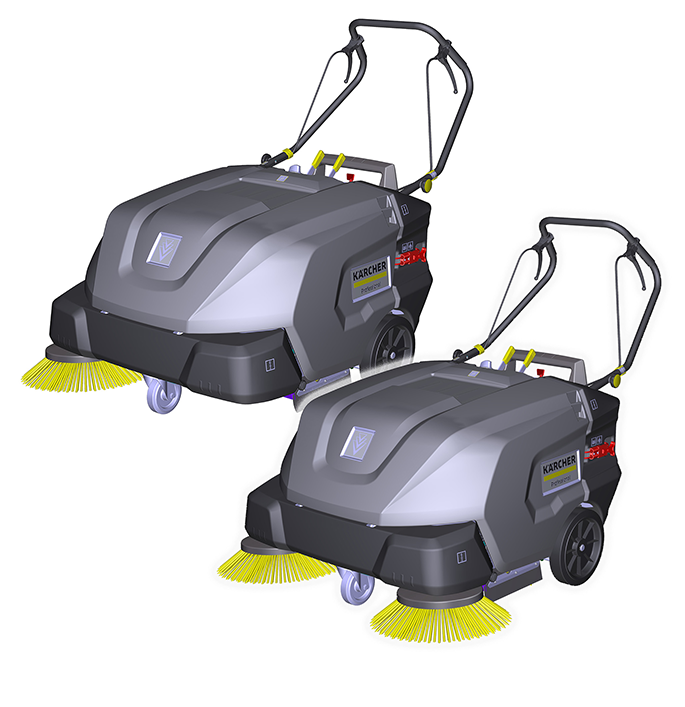
597861500 (11/21)

597861500 (11/21)
 Read these original instructions and the safety instructions chapter before using the device for the first time. Act in accordance with them.
Read these original instructions and the safety instructions chapter before using the device for the first time. Act in accordance with them.
Keep them safe for future reference or for future owners.
Please report any defects or shipping damage identified on the vehicle when it is handed over directly to your dealer or department store.
 The packing materials can be recycled. Please dispose of packaging in accordance with the environmental regulations.
The packing materials can be recycled. Please dispose of packaging in accordance with the environmental regulations.
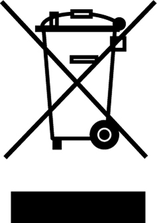 Electrical and electronic appliances contain valuable, recyclable materials and often components such as batteries, rechargeable batteries or oil, which - if handled or disposed of incorrectly - can pose a potential threat to human health and the environment. However, these components are required for the correct operation of the appliance. Appliances marked by this symbol are not allowed to be disposed of together with the household rubbish.
Electrical and electronic appliances contain valuable, recyclable materials and often components such as batteries, rechargeable batteries or oil, which - if handled or disposed of incorrectly - can pose a potential threat to human health and the environment. However, these components are required for the correct operation of the appliance. Appliances marked by this symbol are not allowed to be disposed of together with the household rubbish.
Current information on content materials can be found at: www.kaercher.com/REACH
Vehicles that are no longer fit for service contain valuable recyclable materials. We recommend you cooperate with a waste management company with regard to the disposal of your vehicle.
The warranty conditions issued by our relevant sales company apply in all countries. We shall remedy possible malfunctions on your appliance within the warranty period free of cost, provided that a material or manufacturing defect is the cause. In a warranty case, please contact your dealer (with the purchase receipt) or the next authorised customer service site.
(See overleaf for the address)
Only use original accessories and original spare parts. They ensure that the appliance will run fault-free and safely.
Information on accessories and spare parts can be found at www.kaercher.com.
Indication of an imminent threat of danger that will lead to severe injuries or even death.
Indication of a potentially dangerous situation that may lead to severe injuries or even death.
Indication of a potentially dangerous situation that may lead to minor injuries.
Indication of a potentially dangerous situation that may lead to damage to property.
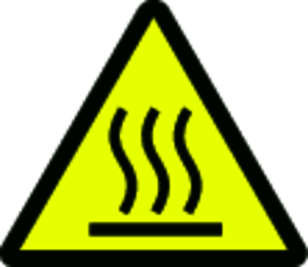 | DANGERRisk of burns from hot surfaces Allow the vehicle to cool down before working on it. |
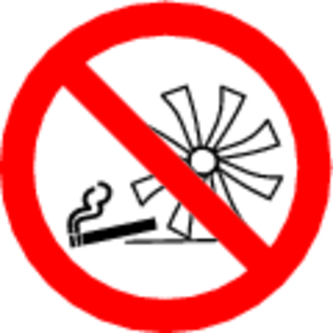 | DANGERRisk of fire Do not sweep up burning or glowing objects such as cigarettes, matches or similar objects. |
 | WARNINGRisk of injury Risk of being squeezed or hurt at the belts, side-brushes, waste container, cover. |
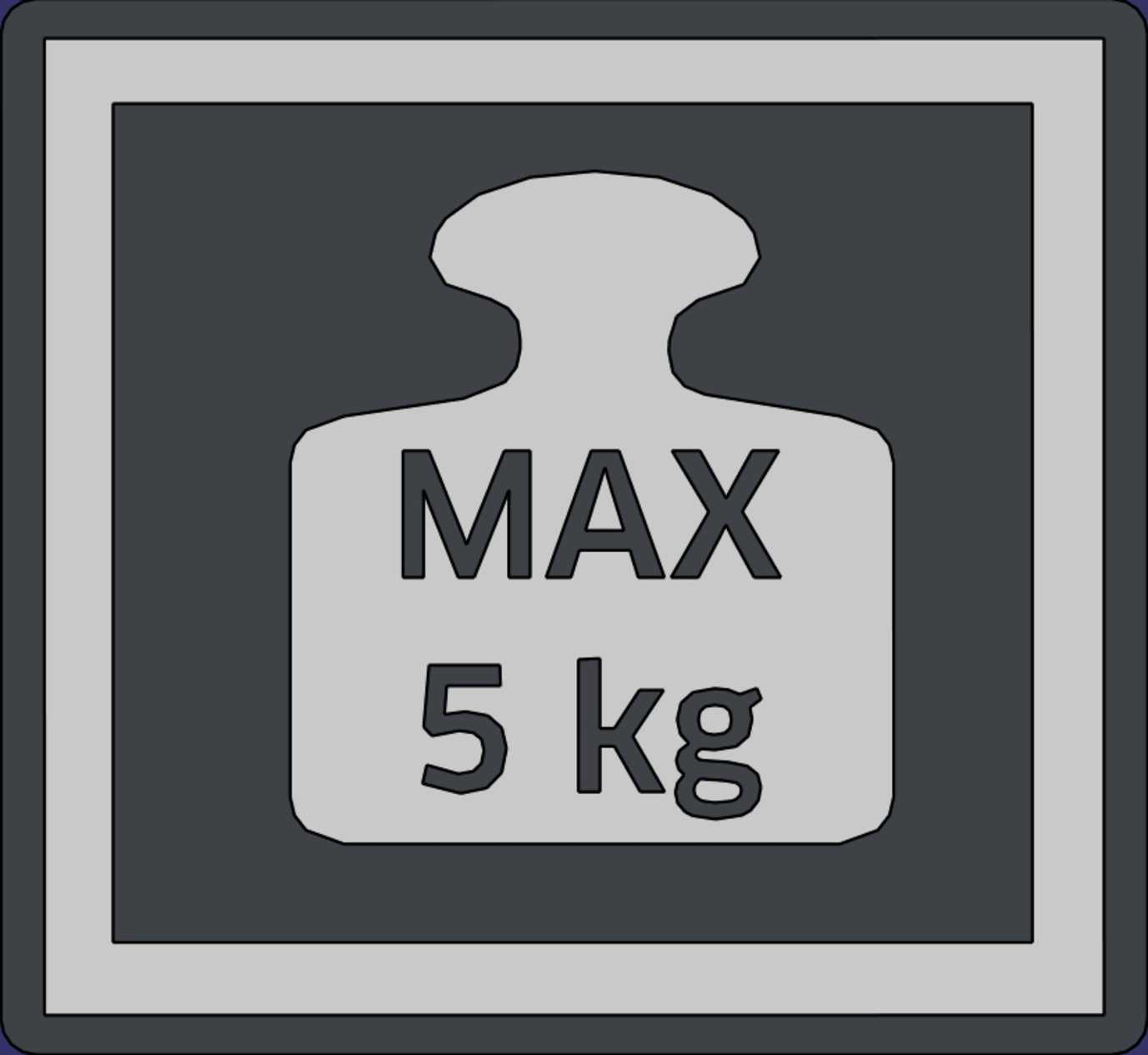 | Max. load on the storage area 5 kg |
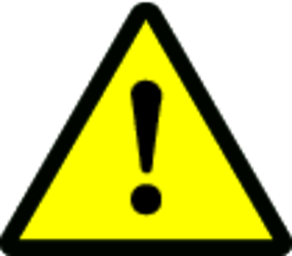 | Warning |
 | Battery charge status indicator |
 | Battery |
 | Charger plug |
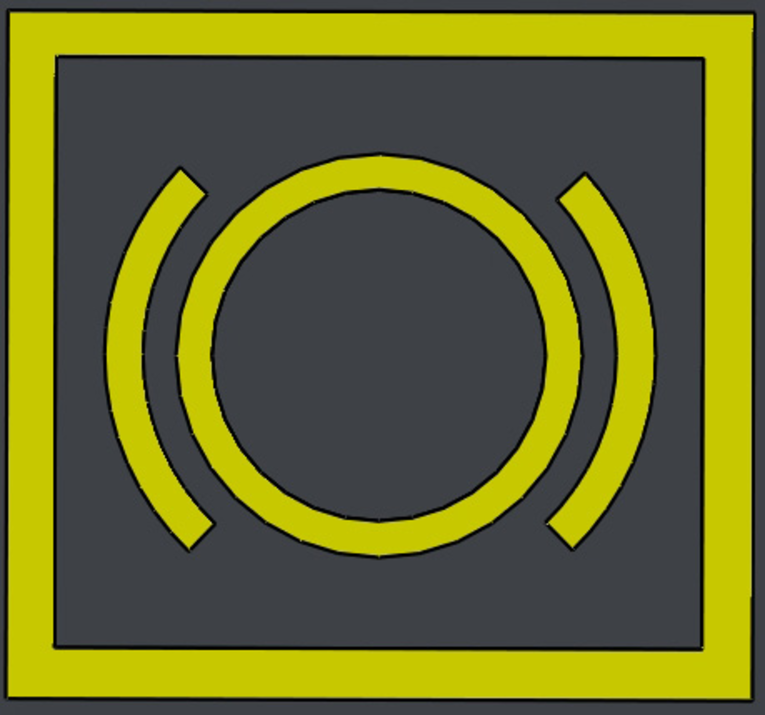 | Brake |
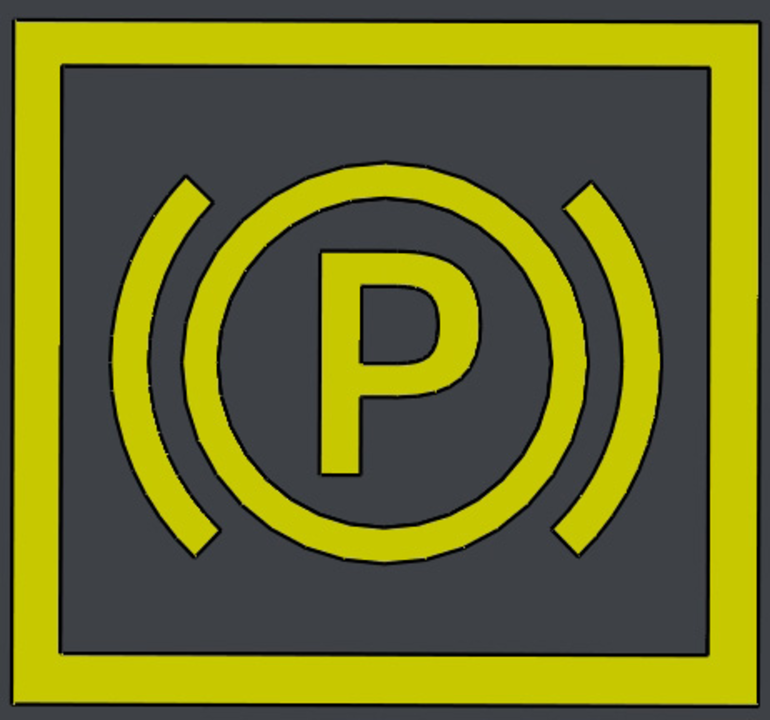 | Parking brake |
 | Travel direction reverse/forward |
 | Operating hours counter |
 | Position for Bowden cable clip |
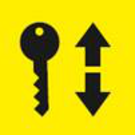 | Insert/remove key position |
 | Key-operated switch in "OFF" position |
 | Key-operated switch in "ON" position |
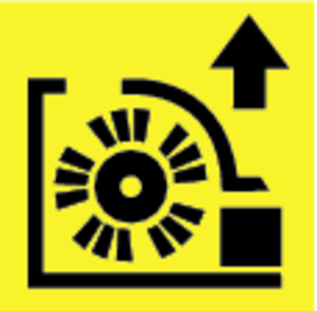 | Coarse dirt flap |
 | Filter dedusting |
 | Filter change |
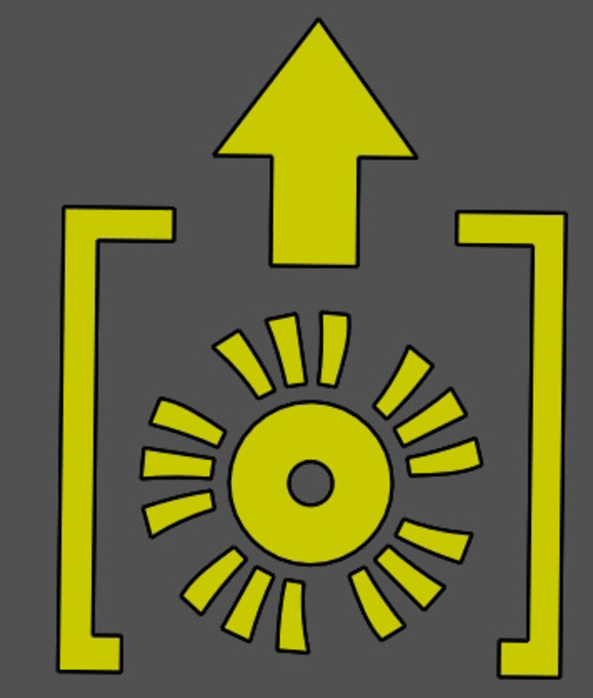 | Raise roller brush |
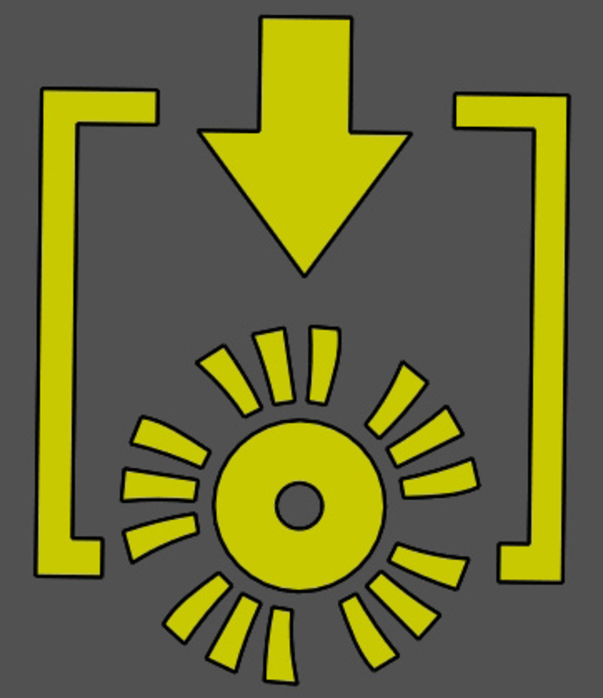 | Lower roller brush |
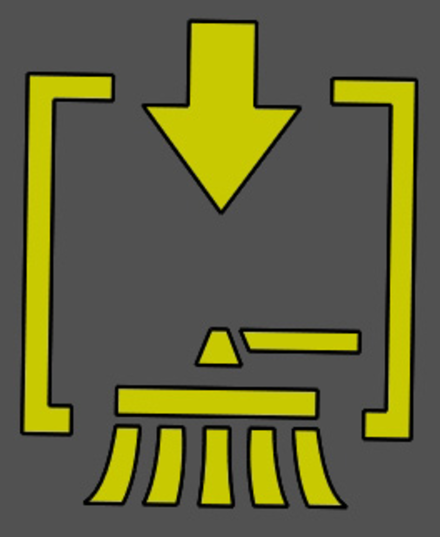 | Lower side brush |
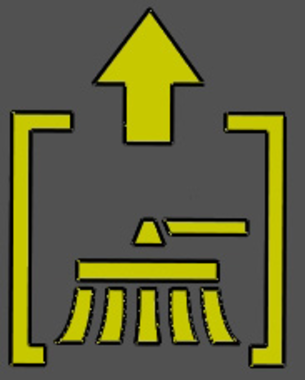 | Raise side brush |
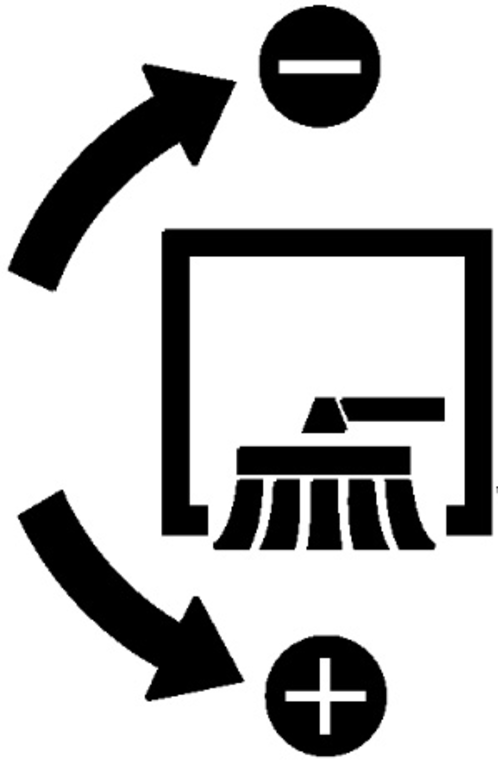 | Side brush sweeping pattern adjustment |
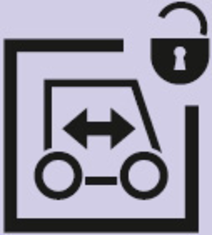 | Travel drive release |
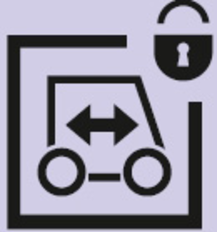 | Travel drive lock |
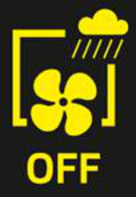 | Blower off (wet sweeping mode) |
 | Blower on (sweeping mode) |
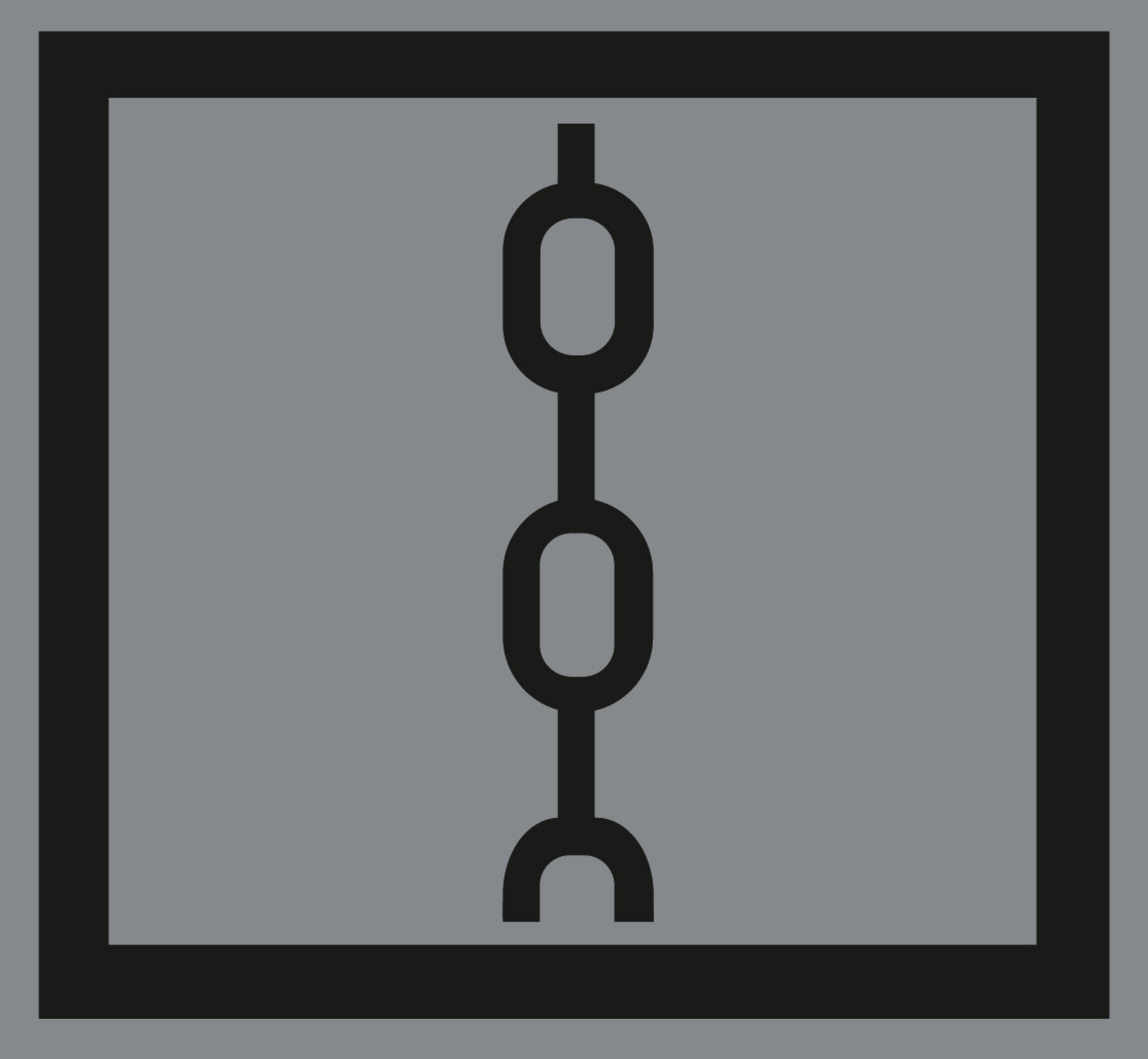 | Lashing point |
Use the battery-operated sweeper for cleaning surfaces indoors and outdoors.
The sweeper is designed for commercial use.
Only use the sweeper in accordance with the information in these operating instructions. Any other use is considered improper use. The manufacturer assumes no liability for any resultant damage. The user is solely responsible for the risk.
No modifications must be made to the sweeper.
Only the areas approved by the company or the company's representatives must be driven on and cleaned.
The device is not designed for continuously driving on slopes.
Do not drive on slopes with a gradient of 15% for longer than 3 minutes.
Never sweep or suction up explosive liquids, gases, non-diluted acids or solvents (e.g. petrol, paint thinner, heating oil) because they form explosive vapours or mixtures in conjunction with the suction air.
Never sweep or suction up acetone, non-diluted acids or solvents, as they will corrode and damage the materials used on the device.
Never sweep or suction up reactive metal dusts (e.g. aluminium, magnesium, zinc). They form explosive gases in conjunction with highly alkaline or acidic cleaning agents.
Do not sweep or suction up burning or smouldering objects. There is a risk of fire.
Do not sweep up any harmful substances.
Standing in hazard zones is prohibited. Operation in explosive spaces is prohibited.
Carrying passengers is prohibited.
This device must not be used to push/pull or transport objects.
Asphalt
Industrial floor
Screed
Concrete
Paving stones
The sweeper operates using the direct-throw principle.
The rotating side brush cleans corners and edges of the sweeping surface, and conveys the waste into the path of the roller brush.
The rotating roller brush conveys the swept material directly into the waste container.
The dust which is swirled up in the waste container is separated by a dust filter, and the suction fan suctions the filtered clean air.
The dust filter is cleaned manually by the user.
Safety devices protect the user and may not taken out of operation or functionally circumvented.
Adhere to the safety instructions in the chapters!
Only use the device for its proper use. Take into account the local conditions and beware of third parties, in particular children, when working with the device.
Check the device with the operating devices to make sure it is in proper condition and operational safe and reliable. If it is not in perfect condition, you must not use it.
Adhere to the respective safety regulations in hazard zones (e.g. service stations). Never operate the device in explosive spaces.
The device is not intended for use by persons with restricted physical, sensory or mental abilities or those lacking in experience and / or lacking in knowledge.
Only people who have been instructed on how to use the device, or have proven their ability to operate it, and have been explicitly instructed to use it, must use the device.
Before starting work, the operator must check whether the safety devices have been attached properly and are fully functional.
The device operator is responsible for accidents with other people and their property.
The operator must wear close-fitting clothing and sturdy footwear. Avoid loose-fitting clothing.
Children must be supervised to prevent them from playing with the appliance.
Children and adolescents must not operate the device.
Check the immediate vicinity before setting off (e.g. children). Make sure you have a sufficient view.
Never leave the device unattended unless the device is secured against unintentional movement. When the device is at a standstill, apply the parking brake and remove the key from the key-operated switch.
Do not use the device in areas in which there is a possibility of being struck by falling objects.
The list on the risk of overturning is not necessarily comprehensive.
Danger of tilting if hill or slope is too steep! Observe the maximum permissible values in the technical data when driving up hills and slopes.
Danger of tilting in case of excessive tilting at side! Observe the maximum permissible values in the technical data when driving lateral to the travel direction.
Danger of tilting on unstable subsurfaces! Only use the device on firm subsurfaces.
Risk of accident due to not adapting speed. Approach corners slowly.
Risk of explosion! Only charge batteries with a suitable charger
Highly explosive gas is produced when charging batteries in confined spaces. Only charge batteries in well ventilated spaces.
Keep naked flames away from the battery or the battery charging room, and do not generate sparks or smoke in the vicinity of a battery of a battery charging room.
Risk of explosion and short circuits. Do not place tools or similar items on the battery.
Risk of injury from battery acid. Adhere to the respective safety regulations.
Adhere to the operating instruction of the manufacturer of the battery and charger. Adhere to the recommendations of the legislature regarding the handling of batteries.
Never leave batteries in a discharged state. Charge batteries again as soon as possible.
Keep batteries clean and dry in order to avoid leakage currents. Protect batteries from contamination, e.g. from metal dust.
Dispose of used batteries in an environmentally friendly manner in accordance with the EC Directive 91/157/EEC or the respective national regulations.
In order to prevent accidents or injuries, you must take into account the weight of the device, see chapter Technical data in the operating instructions.
Shut the motor down prior to transportation. Secure the device, taking into account its weight. See chapter Technical data in the operating instructions.
Disconnect the battery before working on the electrical system.
Switch off the device and pull the key out of the key-operated switch before cleaning, performing maintenance, replacing parts or changing to a different function.
Repairs may only be carried out by approved customer service sites or staff qualified in this area who are familiar with all relevant safety instructions.
Adhere to the safety inspection requirements for mobile devices for industrial use in accordance with the locally applicable regulations (e.g. in Germany: VDE 0701).
Short-circuits or other damage. Do not clean the device with a hose or high-pressure water jet.
Always wear suitable gloves when working on the device.
Risk of accidents when unloading the device
Use a suitable ramp when unloading the device.
Do not use a forklift to unload / load the device.
Be aware of the weight of the device when unloading / loading.
See also the chapter “Technical data”.
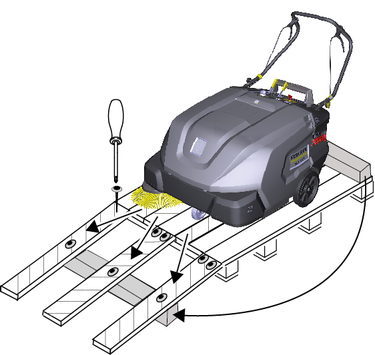
Figure: Build a ramp
Connect the battery and charge if necessary.
Fit the push handle and lever.
Use the enclosed boards to build a ramp according to the sketch.
Cut the plastic packing strips and remove the film.
Remove the strap fastening at the attachment points.
Unscrew the three marked floor boards and the squared timber on the pallet.
Position the boards on the edge of the pallet; align the boards so that they lie in front on the wheels on the device. Screw the boards tight.
Place the squared timber under the boards as a support.
Remove the wooden blocks locking the wheels.
Release the parking brake.
Carefully drive the device off the pallet via the ramp or push it off the pallet (see chapter “Moving the device without its own drive”).
The push handle is removed and placed in the packaging on delivery of the device. This must be mounted on the device.
The hand levers for the brake and the coarse dirt flap are not yet installed and must be attached to the push handle. Adjustments do not need to be made, these are already set correctly at the factory.
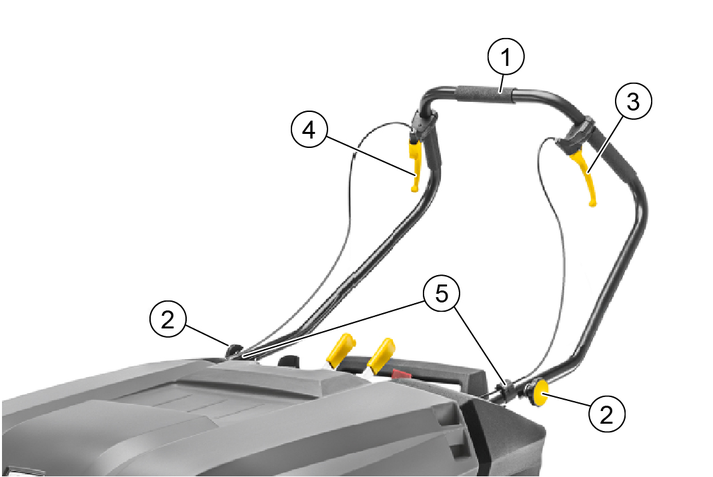
Fasten the push handle with the star screws.
Fasten the hand lever for the coarse dirt flap on the left in the travel direction and the hand lever for the brake on the right on the push handle as shown in the figure.
Fix both sheathed cables with the clips on the push handle.
Risk of crushing fingers
Only use the recessed grip provided to open and close the cover.
Risk of burns from a hot drive motor
The drive motor can get hot during operation.
Do not touch hot surfaces. Pay attention to the warning symbols.
It is necessary to open or remove the cover:
To connect / install the batteries.
for maintenance and cleaning work.
To readjust the side brushes.
The device will not move if the device cover is not completely closed, (cover switch).
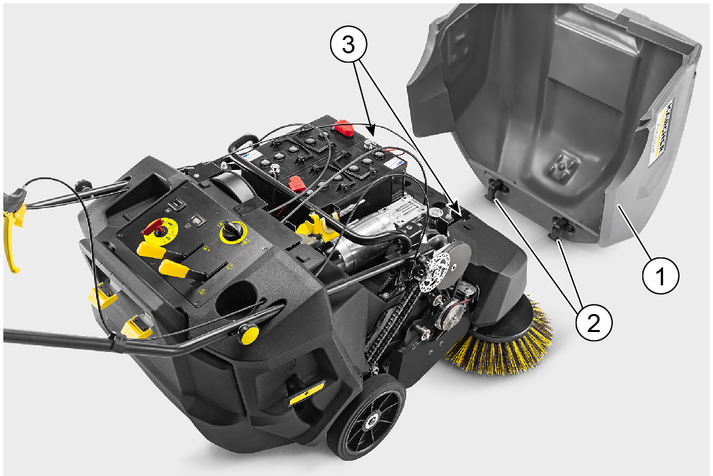
Opening the cover: Grasp the device cover by the recessed grip and slowly swivel it forward. The swivel bearings hold the device cover in its end position.
Removing the cover: Swivel the device cover forwards until just before the end position, then remove it upwards.
Closing the cover: Slowly swivel the device cover back.
The drive must be deactivated to push the device. This is done with a lever mechanism that decouples the drive.
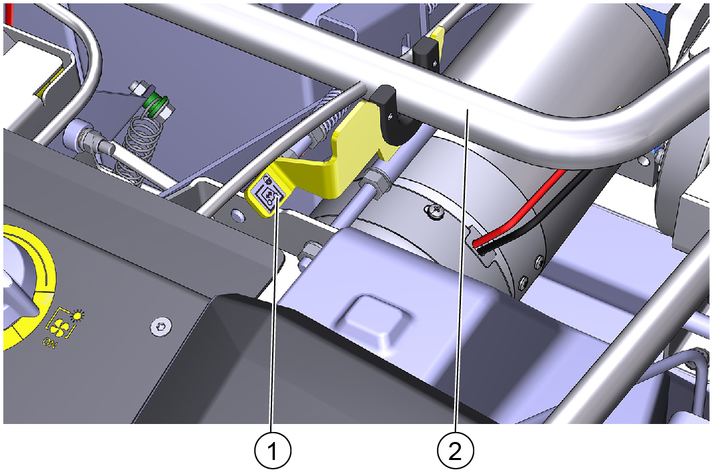
Figure: Lever position up - device can be pushed
Switch off the device and remove the key from the key-operated switch.
Open the cover.
Push the lever up. The drive is decoupled and the push handle is locked.
Device can be pushed.
After moving, push the lever down again.
The side brush(es) are not attached to the device on delivery. They are in the waste container.
Attach the side brushes to the device before initial startup. See chapter "Readjusting/changing the side brushes".
The device is available in 4 different versions:
KM 85/50 W Bp (1.351-116.0)
Without batteries and charger, with 1 side brush
KM 85/50 W Bp *IN (1.351-118.0)
Without batteries and charger, with 1 side brush
KM 85/50 W Bp Pack (1.351-117.0)
With batteries and charger, with 1 side brush
KM 85/50 W Bp Pack 2SB (1.351-119.0)
With batteries and charger, with 2 side brush
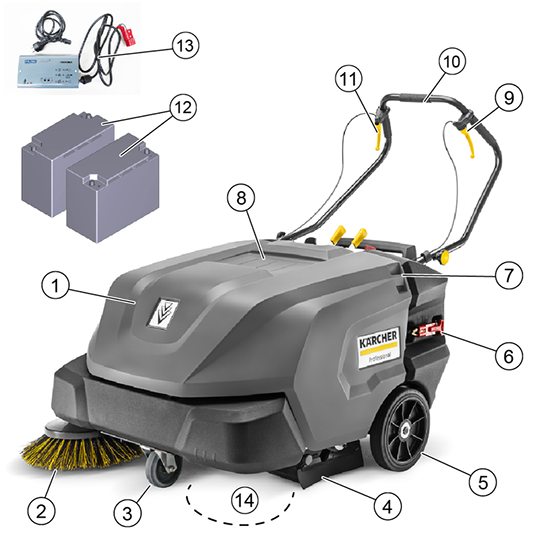
Swivels inwards on contact (protection against damage)
Swivels inwards on contact (protection against damage)
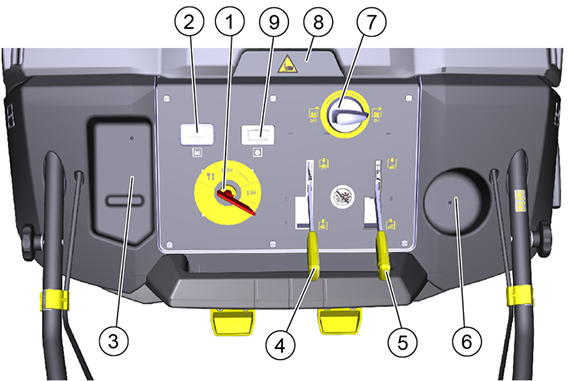
Malfunction
Do not select any intermediate positions
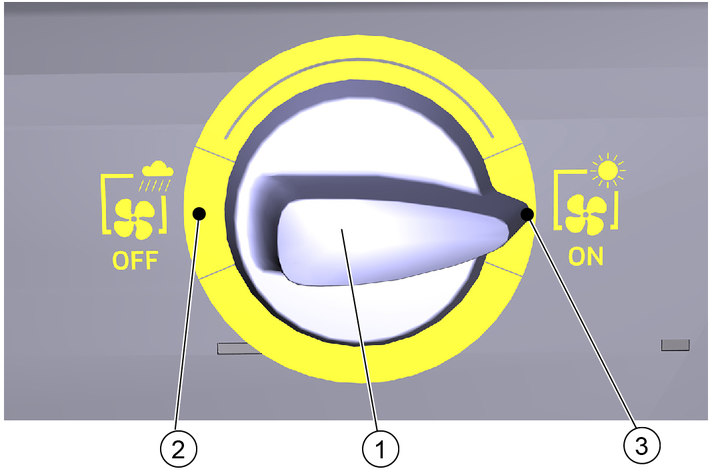
When sweeping dry surfaces: Switch on the blower with the switch.
When sweeping damp surfaces: Switch off the blower with the switch.
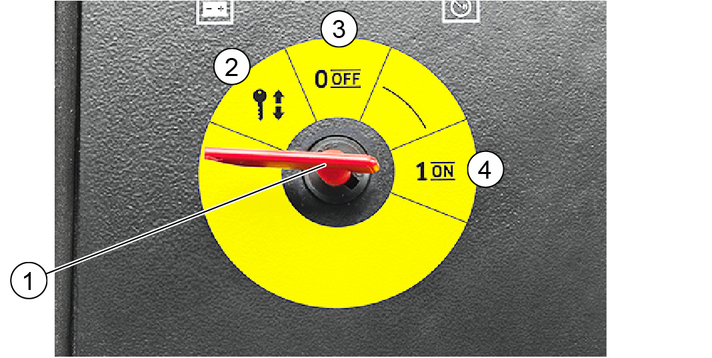
Turn the key-operated switch to the appropriate position, it will lock into place.
Remove the key from the key-operated switch when parking the device.
Health risk
Only operate the filter cleaning when the waste container is fitted.
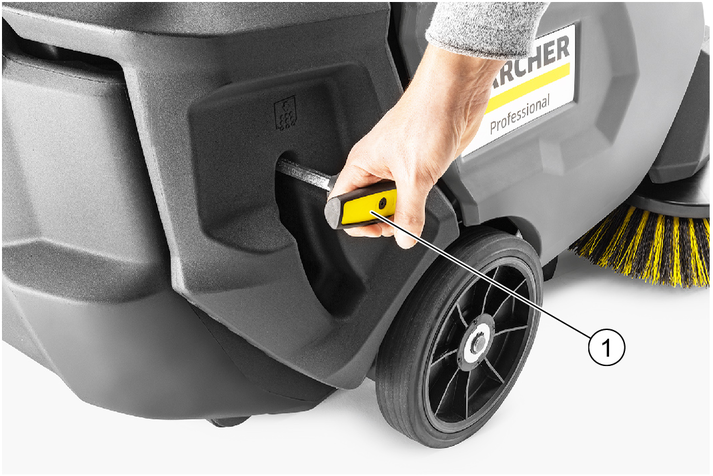
Move the handle back and forth several times to clean the filter.
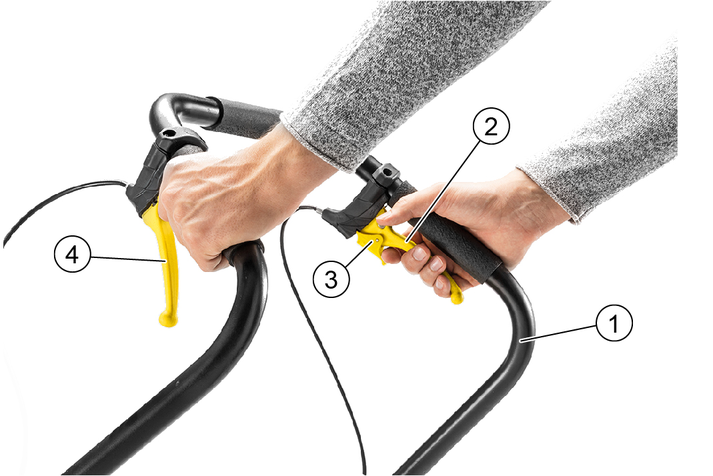
Pull the brake lever to brake.
Apply the parking brake when parking the device.
Pull the brake lever until it can be locked.
To release, pull the brake lever and release the lock.
Always keep the brake disc free from oil or grease. Clean the disc at regular intervals.
To sweep larger objects in, pull the lever and lift the coarse dirt flap.
Pull the lever of the coarse dirt flap to drive over fixed obstacles (up to 30 mm).
When the lever is released, the coarse dirt flap returns to its original position.
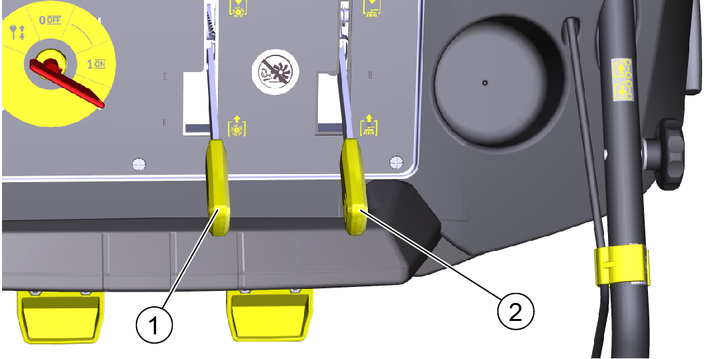
Lower the roller brush.
Lever forwards: The roller brush is lowered - the machine is ready to sweep.
Lever backwards: The lever latches into place. The roller brush rises.
Lower the side brush for cleaning close to the edge.
Lever forwards: The side brush(es) are lowered.
Lever backwards: The lever latches into place. The side brush(es) are raised.
Only use the batteries and chargers recommended by the manufacturer
Only replace batteries with batteries of the same type.
Before disposing of the vehicle, remove the battery and dispose of it in accordance with national or local regulations.
Observe the following warnings when handling the batteries:
 | Observe notes in the instructions for the battery, on the battery and in these operating instructions. |
 | Wear eye protection. |
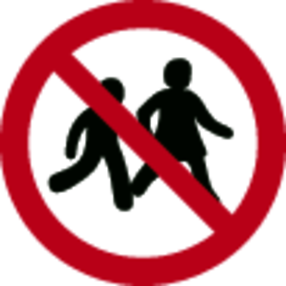 | Keep acids and batteries away from children. |
 | Risk of explosion |
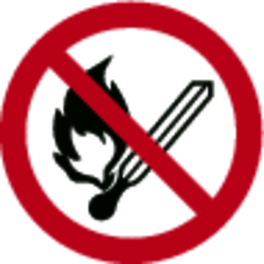 | Fire, sparks, open flames and smoking are prohibited. |
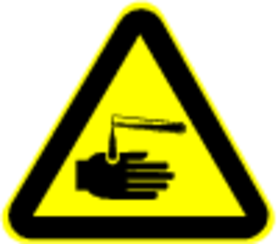 | Risk of acid burns |
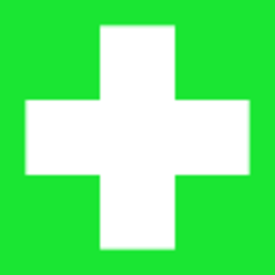 | First aid. |
 | Warning |
 | Disposal |
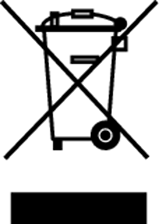 | Do not throw batteries in the bin. |
Risk of fire and explosion
Do not place tools or other objects on the battery.
Naked flames and smoking must be strictly avoided.
Ensure the room is well ventilated when charging batteries.
Only use batteries and chargers approved by Kärcher (original spare parts).
Environmental risk due to improper disposal of batteries
Ensure that defect or used batteries are disposed of safely (contact a waste management company or Kärcher Service).
When used normally, and when observing the instructions, lead-acid batteries do not pose any risk.
However, keep in mind that lead-acid batteries contain sulphuric acid which can cause serious chemical burns and corrosion.
If there is spillage or, if the battery is leaking, acid is escaping, lay down a binding agent such as sand. Do not let it reach the sewer system, soil or a body of water.
Neutralise the acid with lime/baking soda and dispose of it according to local regulations.
Contact a waste management company to dispose of faulty batteries.
Rinse out your eyes or rinse off your skin with copious amounts of fresh water if acid splashes into your eyes or onto your skin.
Then consult a doctor immediately.
Wash any contaminated clothing with water.
Change clothes.
The KM 85/50 W Bp Pack and KM 85/50 W Bp Pack 2SB variants are delivered with batteries and charger.
Kärcher order numbers for recommended batteries and chargers
Battery set Maintenance-free | Order no. * | Volume m3 ** | Airflow m3/h *** |
2 x 12 V / 115 Ah | 2.815-137.0 | 2.64 | 1.06 |
* The order no. of the battery set contains 2 batteries ** Minimum volume of battery charging room *** Minimum airflow between battery charging room and environment | |||
Charger | Order no. | Required quantity |
24 V / 12 A | 6.654-329.0 | 1 |
When using other batteries
Maximum dimensions per battery * | |
L x W x H | 362 x 174 x 290 mm |
* 2 batteries are required | |
Risk of damage as a result of incorrect polarity
Make sure you connect the cables to the correct terminals.
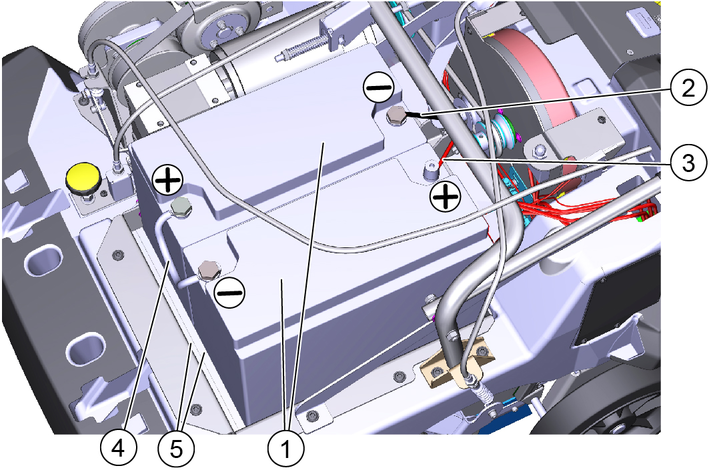
Figure: Installation and connection of the batteries
Switch off the device and remove the key from the key-operated switch.
Open or remove the device cover.
Place both batteries in the mount.
Insert both spacers.
Connect the connection cables as shown.
Connect the negative and positive cables to the battery connector as shown.
Risk of fatal injury from electric shock
Only operate the charger from an appropriate power supply with sufficient fuse protection.
Only use the charger in dry rooms with sufficient ventilation.
Risk of damage due to deep discharge
The device has deep discharge protection, i.e. when the permitted minimum capacity level is reached, you have to drive the device directly to the charging station and avoid slopes.
Risk of damage caused by charger
Do not connect the charger to the device controller plug connector.
Adhere to the safety instructions for charging batteries.
For further information on charging, please read the operating instructions for the charger and act accordingly.
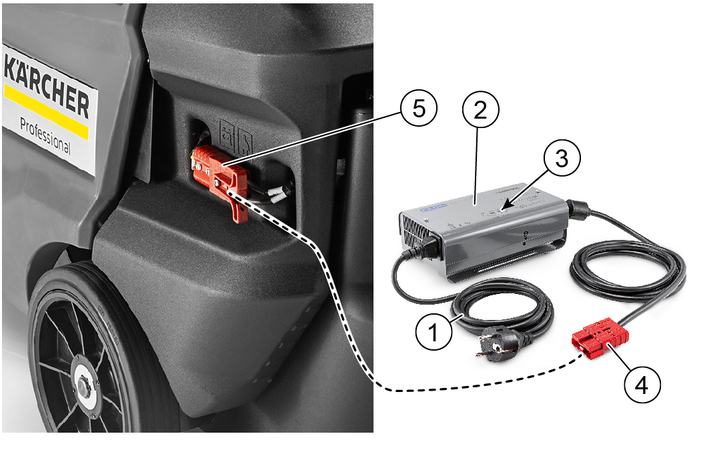
Yellow = battery charging
Green = battery > 80% charged
Green = battery fully charged
Red = battery empty
Shut down the device safely.
Unplug the battery connector at the device.
Connect the charger plug connector to the battery plug connector.
Connect the IEC connector to the charger. Connect the mains cable to the domestic mains socket. The charging process begins.
Carry out the charging process in accordance with the information in the operating instructions for the charger.
Charge the batteries for 10-12 hours.
The recommended chargers (for the respective batteries) are electronically controlled and finish the charging process automatically.
Check the charging state of the battery by setting the key-operated switch to position I (operation).
The charging state of the battery is displayed after approx. 5 seconds with different coloured LEDs (green, yellow, red) on the charge monitoring display.
If the display is yellow or red, charge the battery.
Check the roller brush and side brush for any tangled pieces of tape.
This check can be made with the waste container removed.
For safety reasons, tangled pieces of tape must only be removed when removed.
Operate the manual dust filter cleaning and clean the dust filter.
Empty the waste container.
Risk of accident when reversing
The device can move forward and backward at the same speed.
You should therefore carefully pull the push handle to the rear when reversing.
Insert the key in the key-operated switch and turn to the “I/ON” position, the device is ready for operation.
Release the parking brake.
Driving forward: Push the push handle forward.
Driving in reverse: Pull the push handle back.
To drive over fixed obstacles (up to 30 mm), raise the coarse dirt flap.
Drive over fixed obstacles of more than 30 mm in height only via a suitable ramp.
Risk of injury from stones or chippings
When the coarse dirt flap is open, beware of people, animals and objects in the vicinity (projectile stones or chippings are dangerous).
Do not carry out any cleaning work with the waste container removed.
Risk of damage due to parcel tape or similar material
Do not sweep parcel tape, pieces of string or similar items (damage to the sweeping mechanics).
Adjust the sweeping speed to the conditions in order to achieve optimum cleaning results.
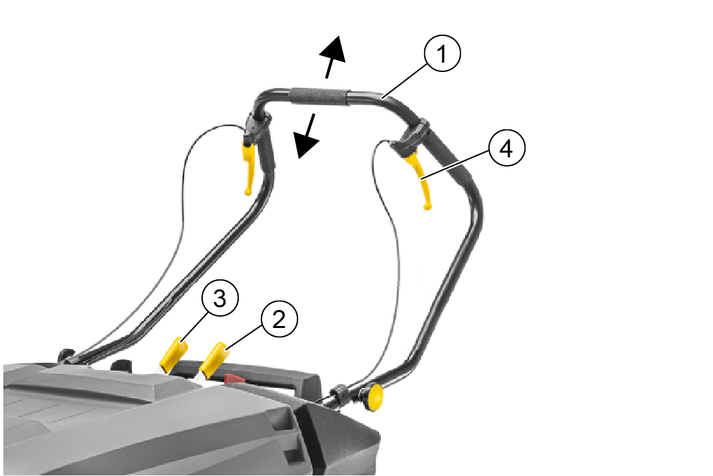
Carry out cleaning work in the forward travel direction by pushing the push handle forward.
Lower the roller brush by pushing the roller brush lever on the control panel forwards. The roller brush lowers.
Switch on the suction fan at the rotary switch on dry surfaces.
Work without a suction fan on wet or damp surfaces.
For cleaning close to the edge, lower the side brush by pushing the side brush lever on the control panel forwards.
The side brush only starts up if the roller brush is switched on.
To pick up larger objects (30 mm), actuate the coarse dirt flap lever.
Clean the dust filter regularly.
To protect the batteries, the device switches itself off completely when the battery charge is low.
Always recharge batteries in good time. See chapter “Charging the batteries”.
If the device has switched itself off, decouple the drive and push the device to the charging station. See chapter “Pushing the device”.
Health risk from dust
Wear a dust mask and safety goggles when emptying the waste container.
Operate the manual dust filter cleaning system several times before emptying the waste container.
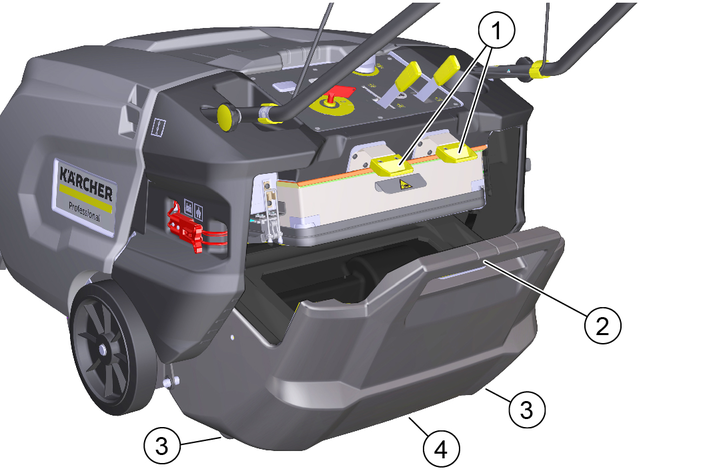
Push both locks of the waste container upwards (open).
Hold the waste container by the handle and pull it out on the transport rollers.
To empty, hold the waste container by the handle and recessed grip.
Push in the waste container completely.
Check whether the waste container has clicked into place.
Park the device on a level surface.
Apply the parking brake.
Remove the key from the key-operated switch.
Raise the roller brush and side brush.
Empty the waste container.
Charge the battery.
Risk of injury and damage
Be aware of the weight of the device during transportation.
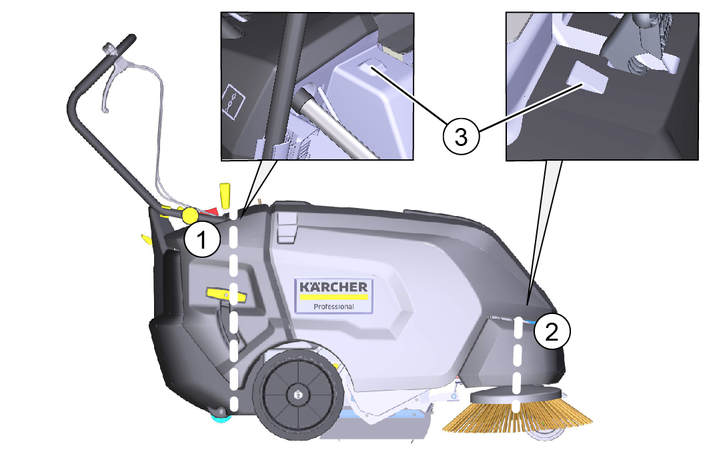
Note the markings for fastening areas on the base frame (chain symbols).
Apply the parking brake.
Remove the battery connector and key from the key-operated switch.
Secure the device to the wheels with wedges.
Secure the device with ropes or lashing straps.
When transporting in vehicles, secure the device against slipping and tipping over according to the applicable guidelines.
Risk of injury and damage
Note the weight of the device.
Place the device in a dry, protected place on an even surface.
Remove the key from the key-operated switch.
Clean the vehicle inside and out.
Pull off the outer battery connector.
Recharge the battery every 2 months.
Risk of accidents and injuries due to unintentional movement of the device
Switch off the device and remove the key from the key-operated switch before carrying out any care and maintenance work.
Disconnect the central battery plug connector.
Adhere to the safety instructions for care and maintenance.
Risk of short circuits due to water stream
Do not clean the device with a hose or high-pressure water jet.
Health risk from dust
Wear a dust mask and safety goggles when cleaning with compressed air.
Risk of damage to the surfaces
Do not use any scouring agents or aggressive cleaning agents for cleaning purposes.
Blow out the inside of the device with compressed air.
Clean the inside and outside of the device with a damp cloth, soaked in mild washing lye.
All servicing and maintenance work must be performed by a qualified specialist. If necessary, you can consult a Kärcher specialist dealer at any time.
Daily maintenance
Check the roller brush and side brush for any tangled pieces of tape.
Check that the control elements are fully functional.
Dedust the dust filter.
Weekly maintenance
Check the moving parts to make sure that they move smoothly.
Check the sealing strips in the sweeping area for correct adjustment and for wear.
Check the roller brush and side brush for wear.
Check the dust filter and clean the filter box as necessary.
Check the tension of belts, check for wear and check that they are functional.
Maintenance after wear
Adjust or change sealing strips.
Replace the roller brush.
Replace the side brush.
Change brake pads.
See chapter "Maintenance work" for descriptions.
To ensure the validity of warranty claims, all servicing and maintenance work during the warranty period must be performed by an authorised Customer Service department.
Have maintenance work carried out according to the inspection checklist.
Check the roller brush and side brush for any tangled pieces of tape.
The inspection can be made with the waste containers removed.
For safety reasons, tangled pieces of tape must only be removed when removed.

Switch off the device and remove the key from the key-operated switch.
Lower the roller brush.
Unscrew the knurled screws.
Remove the bearing plate and cover plate.
Pull out the roller brush.
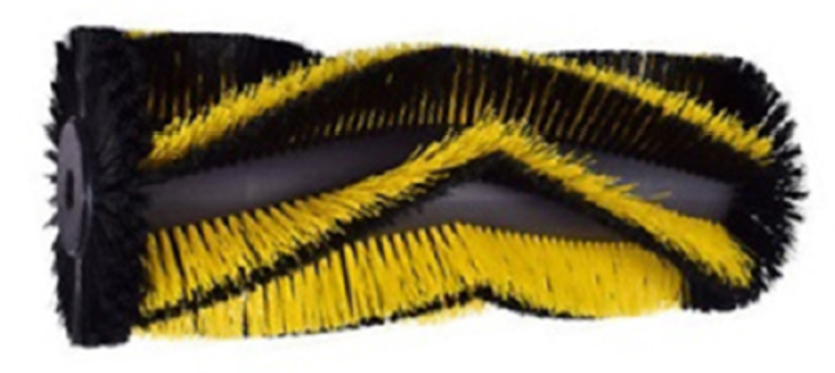
Figure: Installation position seen from the rear (with the waste container removed)
Be sure to install the roller brush in the correct installation position (the roller brush mounts are identical).
Install the cover plate and bearing plate in reverse order.
Adjusting the sweeping pattern
If the side brush is worn, readjust the sweeping pattern using the adjusting screw.
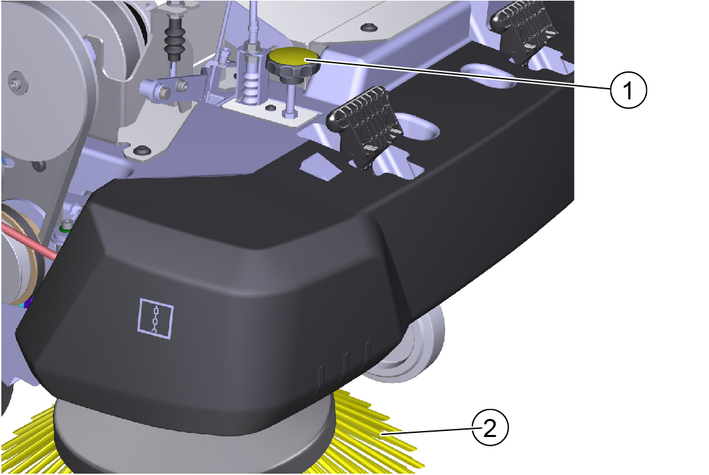
Figure without device cover
Open the cover.
Adjust the sweeping pattern of the side brush with the adjusting screw.
Turn clockwise (-) - the side brush is raised
Turn anticlockwise (+) - the side brush is lowered
If the cleaning performance is not satisfactory despite having readjusted the sweeping pattern several times, the side brush is too worn and needs to be replaced.
Replacing the side brush
Risk of injury and damage
Remove the batteries and the sweep container before tilting the device.
Secure the tipped device before changing the side brush.
Changing the side brush when the device is tilted is described.
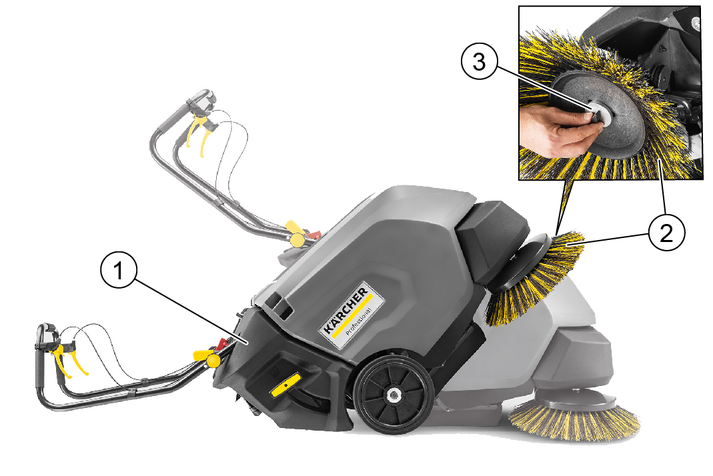
Remove the waste container.
Remove the battery.
Tilt the device to the rear and secure it against tipping down.
Unscrew the screw on the underside.
Remove the side brush.
If necessary, clean the mount.
Attach the new side brush to the driver and fasten it in place with the screw.
Adjust the sweeping pattern with the adjusting screw after changing the side brush.
Health risk from dust
Wear a dust mark and safety goggles when working on the filter system.
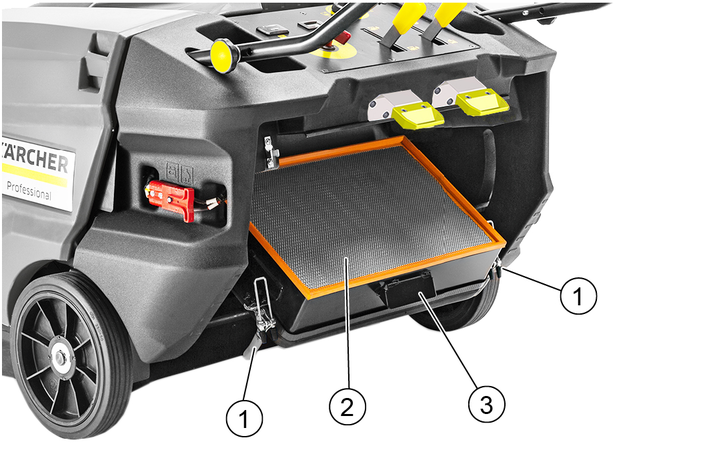
Switch off the device and remove the key from the key-operated switch.
Operate the manual dust filter cleaning.
Open the locks.
Lower the filter box with the dust filter down to the end stop.
Remove the dust filter upwards.
Check the dust filter.
Clean it by vacuuming off dirt or tapping off carefully.
Use a new dust filter if it is damaged or heavily soiled.
Risk of damage to the dust filter.
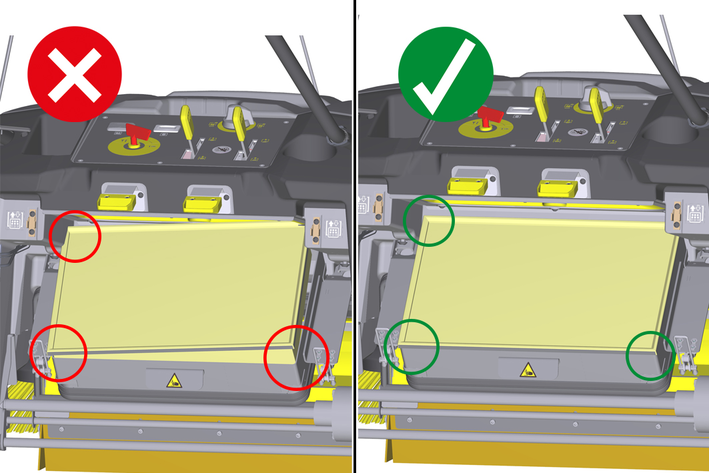
When closing the filter box, make sure that the dust filter is correctly inserted into the filter box. All 4 corners of the dust filter must be flush with the filter box.
Sealing strips | Setting values |
|---|---|
Side sealing strips | Distance from ground 1 - -2 mm |
Front sealing strip | Trailing distance 10-15 mm |
Rear sealing strip | Trailing distance 5-10 mm |
The trailing distance of the front and rear sealing strip defines how much the sealing lip folds backwards when driving the device forwards.
When set correctly, there must be a gap between the side sealing strips and the floor.
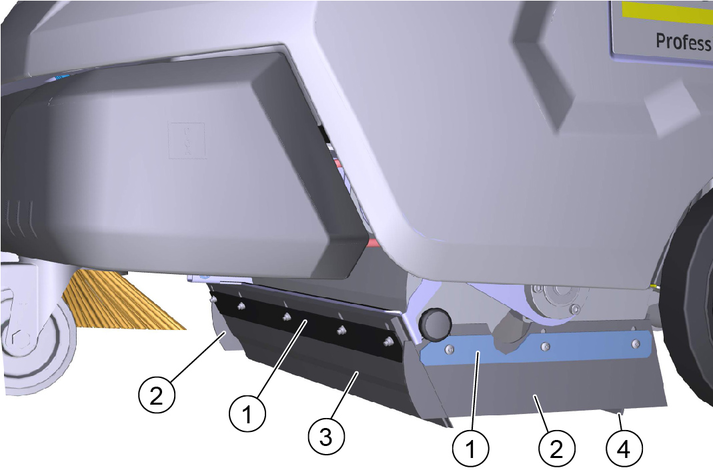
Unfasten the fastening of the sealing strips.
Set the sealing strip by shifting it in the elongated holes.
Refer to the table for the values.
Once the settings are correct, fasten the sealing strips.
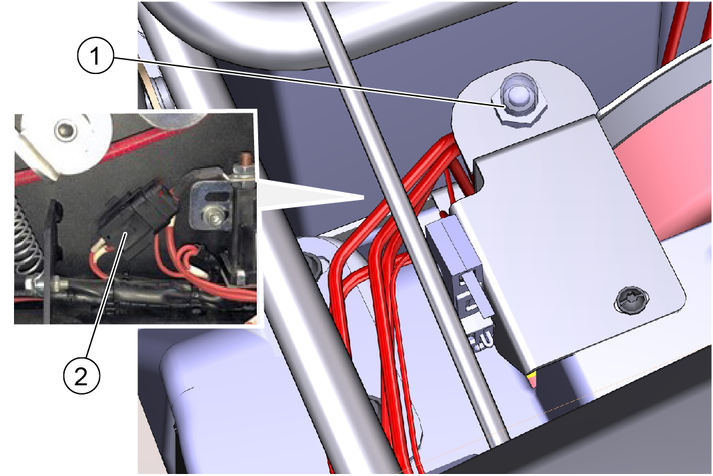
Open the cover.
Replace the defective fuse only with a fuse of the same fuse rating.
The device is ready for use when the main breaker is down.
If the main breaker is up, the breaker has triggered and the device is not ready for operation. Press the breaker.
If the main breaker triggers repeatedly, the cause must be checked. In this case contact Customer Service.
The following is an overview (excerpts thereof) of wear parts or optionally available accessories.
Accessories | Description | Order no. |
|---|---|---|
Side brush, standard | For indoor and outdoor surfaces | 6.906-132.0 |
Side brush, soft | For fine dust, on indoor and outdoor surfaces Moisture resistant | 6.905-626.0 |
Side brush, hard | For removal of stubborn dirt, for outdoor use Moisture resistant | 6.905-625.0 |
Roller brush, standard | For indoor and outdoor surfaces Wear and moisture resistant | 4.762-430.0 |
Roller brush, soft | For fine dust, on indoor and outdoor surfaces Moisture resistant | 4.762-442.0 |
Roller brush, hard | For removal of stubborn dirt, for outdoor use Moisture resistant | 4.762-443.0 |
Dust filter | Replace the flat filter at least 1x annually Moisture resistant, washable | 5.731-585.0 |
Sealing strip, side Left and right | 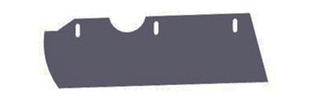 | 5.400-723.0 |
Sealing strip, rear |  | 5.394-834.0 |
Sealing strip, front |  | 5.394-832.0 |
Side brush attachment kit, left | Has to be installed by Customer Service | 2.850-266.0 |
Home Base accessories | Description | Order no. |
|---|---|---|
Adapter | For securing to Home Base rail (device) | 5.035-488.0 |
Double hook | Can only be used in conjunction with adapter | 6.980-077.0 |
Detergent container | Can only be used in conjunction with adapter | 4.070-006.0 |
Coarse dirt pliers set | Coarse dirt pliers including attachment to the device | 4.035-524.0 |
You can remedy minor faults using the following overview.
Contact the Customer Service department in the case of any faults not listed!
Risk of accidents and injuries due to unintentional movement of the device
Switch off the device and remove the key from the key-operated switch before carrying out any care and maintenance work.
Unplug the central battery connector or disconnect the battery.
Risk of electric shock
When working on electronic components, unplug the battery plug or disconnect the battery.
Repair work and work on electrical components must only be performed by your authorised Customer Service.
Cause:
Remedy:
Key-operated switch to position I.
Activate travel drive (deactivate decoupling).
Charge the battery.
Check the belt and chain.
Check main breaker, activate it by pressing if it has triggered.
Check the connected battery terminals.
Check the central battery connector.
Fully close the device cover (cover switch).
Cause:
Remedy:
Empty the waste container.
Check / replace the seals.
Check / clean / replace the dust filter.
Check that the dust filter is seated correctly.
In case of light soiling, clean the dust filter.
In case of damage or heavy soiling, replace the dust filter.
Check the sealing strips for wear / set / replace them.
When dry sweeping: Switch on the blower.
Completely raise the side brush.
Cause:
Remedy:
Check the roller brush and side brushes for wear, adjust the sweeping pattern or replace if necessary.
Check the sealing strips for wear, adjust or replace them if necessary.
Check that the coarse dirt flap is fully functional.
Check that the roller brush is correctly in place.
Cause:
Remedy:
Lower the roller brush and/or side brushes.
Remedy:
Check the adjustment of the Bowden cables.
Remedy:
Contact Customer Service.
Cause:
Remedy:
Check the roller brush / side brush for any tangled pieces of tape.
Remedy:
Have the micro switch checked by Customer Service.
Device performance data | |
Operation duration with fully loaded battery | 2,5 h |
Travel speed, forwards | 4,5 km/h |
Travel speed, backwards | 4,5 km/h |
Climbing ability (max.) | 15 % |
Working width without side brushes | 615 mm |
Working width with 1 side brushes | 850 mm |
Theoretical surface performance | |
Surface performance with 1 side brushes | 3825 m2/h |
Degree of protection | IPX3 |
Battery | |
Battery type | --- |
Battery capacity | --- Ah |
Working voltage of the battery | 24 V |
Charger | |
Frequency | --- Hz |
Protection class | --- |
Ambient conditions | |
Ambient temperature | -5 bis +40 °C |
Humidity, non-condensing | 0 - 90 % |
Dimensions and weights | |
Length | 1550 mm |
Width | 1000 mm |
Height | 1120 mm |
Weight | 140 kg |
Approved total weight | 300 kg |
Waste container | |
Waste container volume | 50 l (kg) |
Filter and suction system | |
Filter system | Flat fold filter, manual cleaning |
Filter area | 2,3 m2 |
Dust class | M |
Suction system nominal negative pressure | 0,5 mbar |
Determined values in acc. with EN 60335-2-72 | |
Hand-arm vibration value | 2,4 m/s2 |
Uncertainty K | 0,2 m/s2 |
Sound pressure level LpA | 66 dB(A) |
Uncertainty KpA | 3 dB(A) |
Sound power level LWA + K uncertaintyWA | 84 dB(A) |
Uncertainty KWA | 3 dB(A) |
Device performance data | |
Operation duration with fully loaded battery | 2,5 h |
Travel speed, forwards | 4,5 km/h |
Travel speed, backwards | 4,5 km/h |
Climbing ability (max.) | 15 % |
Working width without side brushes | 615 mm |
Working width with 1 side brushes | 850 mm |
Theoretical surface performance | |
Surface performance with 1 side brushes | 3825 m2/h |
Degree of protection | IPX3 |
Battery | |
Battery type | Maintenance-free |
Battery capacity | 115 Ah |
Working voltage of the battery | 2x12 = 24 V |
Charger | |
Mains voltage | 95 - 253 V |
Frequency | 50/60 Hz |
Protection class | II |
Ambient conditions | |
Ambient temperature | -5 bis +40 °C |
Humidity, non-condensing | 0 - 90 % |
Dimensions and weights | |
Length | 1550 mm |
Width | 1000 mm |
Height | 1120 mm |
Weight | 226 kg |
Approved total weight | 300 kg |
Waste container | |
Waste container volume | 50 l (kg) |
Filter and suction system | |
Filter system | Flat fold filter, manual cleaning |
Filter area | 2,3 m2 |
Dust class | M |
Suction system nominal negative pressure | 0,5 mbar |
Determined values in acc. with EN 60335-2-72 | |
Hand-arm vibration value | 2,4 m/s2 |
Uncertainty K | 0,2 m/s2 |
Sound pressure level LpA | 66 dB(A) |
Uncertainty KpA | 3 dB(A) |
Sound power level LWA + K uncertaintyWA | 84 dB(A) |
Uncertainty KWA | 3 dB(A) |
Device performance data | |
Operation duration with fully loaded battery | 2,5 h |
Travel speed, forwards | 4,5 km/h |
Travel speed, backwards | 4,5 km/h |
Climbing ability (max.) | 15 % |
Working width without side brushes | 615 mm |
Working width with 1 side brushes | 850 mm |
Working width with 2 side brushes | 1085 mm |
Theoretical surface performance | |
Surface performance with 1 side brushes | 3825 m2/h |
Surface performance with 2 side brushes | 4882 m2/h |
Degree of protection | IPX3 |
Battery | |
Battery type | Maintenance-free |
Battery capacity | 115 Ah |
Working voltage of the battery | 2x12 = 24 V |
Charger | |
Mains voltage | 95 - 253 V |
Frequency | 50/60 Hz |
Protection class | II |
Ambient conditions | |
Ambient temperature | -5 bis +40 °C |
Humidity, non-condensing | 0 - 90 % |
Dimensions and weights | |
Length | 1550 mm |
Width | 1100 mm |
Height | 1120 mm |
Weight | 227 kg |
Approved total weight | 300 kg |
Waste container | |
Waste container volume | 50 l (kg) |
Filter and suction system | |
Filter system | Flat fold filter, manual cleaning |
Filter area | 2,3 m2 |
Dust class | M |
Suction system nominal negative pressure | 0,5 mbar |
Determined values in acc. with EN 60335-2-72 | |
Hand-arm vibration value | 2,4 m/s2 |
Uncertainty K | 0,2 m/s2 |
Sound pressure level LpA | 66 dB(A) |
Uncertainty KpA | 3 dB(A) |
Sound power level LWA + K uncertaintyWA | 84 dB(A) |
Uncertainty KWA | 3 dB(A) |
EU Declaration of Conformity |
We hereby declare that the machine described below complies with the relevant basic safety and health requirements in the EU Directives, both in its basic design and construction as well as in the version placed in circulation by us. This declaration is invalidated by any changes made to the machine that are not approved by us.
Product: Sweeper vacuum
Type: 1.351-xxx.0
Currently applicable EU Directives2006/42/EC (+2009/127/EC)
2014/30/EU
2000/14/EC
2011/65/EU
Harmonised standards usedEN 60335-1
EN 60335-2-29
EN 60335-2-72
EN 55012: 2007 + A1: 2009
EN 55014-1: 2006+A1: 2009+A2: 2011
EN 55014-2: 1997+A1: 2001+A2: 2008
EN 61000-3-2: 2014
EN 61000-3-3: 2013
EN 61000-6-2: 2005
EN 62233: 2008
Applied conformity evaluation method2000/14/EG: Annex V
Sound power level dB(A)Measured: 82
Guaranteed: 83
The signatories act on behalf of and with the authority of the company management.

Documentation supervisor:
S. Reiser
Alfred Kärcher SE & Co. KG
Alfred-Kärcher-Str. 28 - 40
71364 Winnenden (Germany)
Ph.: +49 7195 14-0
Fax: +49 7195 14-2212
Winnenden, 2021/02/01
Declaration of Conformity(UK) |
We hereby declare that the product described below complies with the relevant provisions of the following UK Regulations, both in its basic design and construction as well as in the version put into circulation by us. This declaration shall cease to be valid if the product is modified without our prior approval.
Product: Sweeper vacuum
Type: 1.351-xxx.0
Currently applicable UK RegulationsS.I. 2008/1597 (as amended)
S.I. 2016/1091 (as amended)
S.I. 2001/1701 (as amended)
S.I. 2012/3032 (as amended)
Designated standards usedEN 60335-1
EN 60335-2-29
EN 60335-2-72
EN 55012: 2007 + A1: 2009
EN 55014-1: 2006+A1: 2009+A2: 2011
EN 55014-2: 1997+A1: 2001+A2: 2008
EN 61000-3-2: 2014
EN 61000-3-3: 2013
EN 61000-6-2: 2005
EN 62233: 2008
Applied conformity assessment procedureS.I. 2001/1701 (as amended): Schedule 8
Sound power level dB(A)Measured: 82
Guaranteed: 83
The signatories act on behalf of and with the authority of the company management.

Documentation supervisor:
S. Reiser
Alfred Kärcher SE & Co. KG
Alfred-Kärcher-Str. 28 - 40
71364 Winnenden (Germany)
Ph.: +49 7195 14-0
Fax: +49 7195 14-2212
Winnenden, 2021/02/01